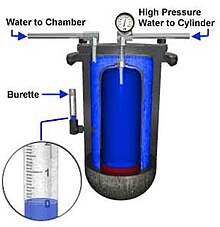

Transportable pressure vessels for high-pressure gases are routinely inspected and tested as part of the manufacturing process. They are generally marked as evidence of passing the tests, either individually or as part of a batch (some tests are destructive), and certified as meeting the standard of manufacture by the authorised testing agency, making them legal for import and sale.[citation needed] When a cylinder is manufactured, its specification, including manufacturer, working pressure, test pressure, date of manufacture, capacity and weight are stamped on the cylinder.[1]
Most countries require diving cylinders to be checked on a regular basis. This usually consists of an internal visual inspection and a hydrostatic test. The inspection and testing requirements for scuba cylinders may be very different from the requirements for other compressed gas containers due to the more corrosive environment in which they are used.[2] After a cylinder passes the test, the test date, (or the test expiry date in some countries such as Germany), is punched into the shoulder of the cylinder for easy verification at fill time.[note 1] The international standard for the stamp format is ISO 13769, Gas cylinders - Stamp marking.[1]
A hydrostatic test involves pressurising the cylinder to its test pressure (usually 5/3 or 3/2 of the working pressure) and measuring its volume before and after the test. A permanent increase in volume above the tolerated level means the cylinder fails the test and must be permanently removed from service.[3]: sect. 5.7.3
An inspection may include external and internal inspection for damage, corrosion, and correct colour and markings. The failure criteria vary according to the published standards of the relevant authority, but may include inspection for bulges, overheating, dents, gouges, electrical arc scars, pitting, line corrosion, general corrosion, cracks, thread damage, defacing of permanent markings, and colour coding.[3]: sect. 5.7.3 [2]
Gas filling operators may be required to check the cylinder markings and perform an external visual inspection before filling the cylinder and may refuse to fill non-standard or out-of-test cylinders.[note 2]
Cite error: There are <ref group=note> tags on this page, but the references will not show without a {{reflist|group=note}} template (see the help page).
© MMXXIII Rich X Search. We shall prevail. All rights reserved. Rich X Search
